
Introduction
Goals and Goal Setting
Goals Common to All RST Writers
Other Goals to Consider
Defining My Own Goals
Advice about Assignments
Getting Started: Listing Topics to Write about in the Tutorial
Narrative One: Personal Piece on a Significant Experience
Narrative Two: Academic Piece on a Significant Experience
Summary/Response One
Summary/Response Two
Tutorial Evaluation Postscript
On Using the Resources for Writers
Generating and Developing Ideas
Finding/Expressing Main Ideas
Showing v. Telling Sentences
Focusing Topic Sentences
Thesis Statements
Reading Strategies
Assessing Your Reading Strategies
Summarizing

Writing Effective Summary and Response Essays
Discourse Analysis Worksheet
Trade Magazines
Selecting Readings
A summary is a concise paraphrase of all the main ideas in an essay. It cites the author and the title (usually in the first sentence); it contains the essay's thesis and supporting ideas; it may use direct quotation of forceful or concise statements of the author's ideas; it will NOT usually cite the author's examples or supporting details unless they are central to the main idea. Most summaries present the major points in the order that the author made them and continually refer back to the article being summarized (i.e. "Damon argues that ..." or "Goodman also points out that ... "). The summary should take up no more than one-third the length of the work being summarized.
The Response:
A response is a critique or evaluation of the author's essay. Unlike the summary, it is composed of YOUR opinions in relation to the article being summarized. It examines ideas that you agree or disagree with and identifies the essay's strengths and weaknesses in reasoning and logic, in quality of supporting examples, and in organization and style. A good response is persuasive; therefore, it should cite facts, examples, and personal experience that either refutes or supports the article you're responding to, depending on your stance.
Two Typical Organizational Formats for Summary/Response Essays:
1. Present the summary in a block of paragraphs, followed by the response in a block:
Intro/thesis Summary (two to three paragraphs) Agreement (or disagreement) Disagreement (or agreement) Conclusion
Note: Some essays will incorporate both agreement and disagreement in a response, but this is not mandatory.
2. Introduce the essay with a short paragraph that includes your thesis. Then, each body paragraph summarizes one point and responds to it, and a conclusion wraps the essay up.
Intro/thesis Summary point one; agree/disagree Summary point two; agree/disagree Summary point three; agree/disagree Conclusion
- PRO Courses Guides New Tech Help Pro Expert Videos About wikiHow Pro Upgrade Sign In
- EDIT Edit this Article
- EXPLORE Tech Help Pro About Us Random Article Quizzes Request a New Article Community Dashboard This Or That Game Forums Popular Categories Arts and Entertainment Artwork Books Movies Computers and Electronics Computers Phone Skills Technology Hacks Health Men's Health Mental Health Women's Health Relationships Dating Love Relationship Issues Hobbies and Crafts Crafts Drawing Games Education & Communication Communication Skills Personal Development Studying Personal Care and Style Fashion Hair Care Personal Hygiene Youth Personal Care School Stuff Dating All Categories Arts and Entertainment Finance and Business Home and Garden Relationship Quizzes Cars & Other Vehicles Food and Entertaining Personal Care and Style Sports and Fitness Computers and Electronics Health Pets and Animals Travel Education & Communication Hobbies and Crafts Philosophy and Religion Work World Family Life Holidays and Traditions Relationships Youth
- Browse Articles
- Learn Something New
- Quizzes Hot
- Happiness Hub
- This Or That Game
- Train Your Brain
- Explore More
- Support wikiHow
- About wikiHow
- Log in / Sign up
- Education and Communications
- College University and Postgraduate
- Academic Writing
How to Write a Summary
Last Updated: July 26, 2024 Approved
Reviewing the Piece
Writing the summary in your own words, revising your draft into a coherent summary, sample summaries, expert q&a.
This article was co-authored by Richard Perkins . Richard Perkins is a Writing Coach, Academic English Coordinator, and the Founder of PLC Learning Center. With over 24 years of education experience, he gives teachers tools to teach writing to students and works with elementary to university level students to become proficient, confident writers. Richard is a fellow at the National Writing Project. As a teacher leader and consultant at California State University Long Beach's Global Education Project, Mr. Perkins creates and presents teacher workshops that integrate the U.N.'s 17 Sustainable Development Goals in the K-12 curriculum. He holds a BA in Communications and TV from The University of Southern California and an MEd from California State University Dominguez Hills. wikiHow marks an article as reader-approved once it receives enough positive feedback. This article received 26 testimonials and 85% of readers who voted found it helpful, earning it our reader-approved status. This article has been viewed 1,841,133 times.
Writing a summary is a great way to process the information you read, whether it’s an article or a book. If you’re assigned a summary in school, the best way to approach it is by reviewing the piece you’re summarizing. Read it thoroughly and take notes on the major points you want to include in your summary. When you get to writing your summary, rely on your memory first to make sure the summary is in your own words. Then, revise it to ensure that your writing is clear and the grammar, punctuation, and spelling are all perfect.
How do you write a good summary?
Start by reviewing the piece and identifying what the major points of it are. Highlight the author and the name of their work first, and then try to recall all of the major plot points from memory. Tighten up your draft by ensuring that your content is in chronological order, and by checking for errors or repetition.

- The author might also state their thesis more plainly by saying something like "my argument is...." or I believe...
- In a fiction piece, the author will more likely emphasize themes. So if you notice that love - discussions or descriptions of it, for example - come up a lot, one of the main points of the piece is probably love.

- To put something in your own words, write it down as if you were explaining or describing it to a friend. In that case, you wouldn't just read what the author wrote. Do the same when you're writing down the major points in your own words.

- For fiction pieces, this means avoiding rewriting every single thing that happens in the piece. Focus instead on the major plot points and the main motivator for those points. Don't include everything that happens to the character along the way.

- For example, you can start with something like “George Shaw’s '‘Pygmalion’' is a play that addresses issues of class and culture in early twentieth-century England.”

- If you absolutely must use the original author’s words, put them in quotation marks. This tells your reader those words aren’t yours. Not doing this is academic plagiarism, and it can get you in a lot of trouble.
- Make sure you format the quote correctly!

- For example, you might think that Hamlet spends a lot of time thinking and not a lot of time acting. You can say something like, "Hamlet is a man of thought, rather than action," instead of saying, "Why doesn't Hamlet do something once in a while?"

- In fiction pieces, you can say something like "Shakespeare's Hamlet then spends a lot of time brooding on the castle ramparts." This tells your reader you're talking about Shakespeare's play, not inventing your own story.

- For example, in a summary of an article about the cause of the American Revolution, you might have a paragraph that summarizes the author's arguments about taxes, and another about religious freedom. You can say something like, "Although some colonists believed that taxes should entitle them to representation in Parliament, the author also argues that other colonists supported the Revolution because they believed they were entitled to representation in heaven on their own terms."

- Don't use spell-checker for spelling errors. It will catch if you spell something wrong, but not if you use the wrong spelling of a word. For example, it won't catch that you used "there" when you meant "their."

- Generally, a summary should be around one quarter the length of the original piece. So if the original piece is 4 pages long, your summary should be no more than 1 page. [13] X Research source

- Not only should they be comparing your work for accuracy, ask them to read it for flow and summation. They should be able understand what happened in the article or story by reading your summary alone. Don't hesitate to ask for criticism; then weigh those criticisms and make valid changes.

- If you notice an author has made the same point multiple times, though, it’s a good indicator that this is an important point, and it should definitely be in your summary. Thanks Helpful 0 Not Helpful 0
Tips from our Readers
- Start your summary out with where the story takes place, or something that is on the first page or in the first chapter.
- Look at the chapter title of the book.This might help summarize the chapter as you start working on your summary.

You Might Also Like

- ↑ http://teacher.scholastic.com/reading/bestpractices/comprehension/authorsmainidea.pdf
- ↑ Richard Perkins. Writing Coach. Expert Interview. 1 September 2021.
- ↑ http://utminers.utep.edu/omwilliamson/engl0310/summaryhints.htm
- ↑ https://public.wsu.edu/~mejia/Summary.htm
- ↑ http://www.hunter.cuny.edu/rwc/handouts/the-writing-process-1/invention/Guidelines-for-Writing-a-Summary
About This Article

Before you write a summary, read the piece you’re summarizing, then make notes on what you think the main point and major supporting arguments are. When you’re ready to draft your summary, start with the author and title, then use your own words to write what you think the author’s main point is in each section. Be sure to focus on what the author thinks and feels rather than what you do! Finally, reread your summary and check it for good spelling, punctuation, and grammar. For more suggestions from our reviewer about polishing your summary and improving transitions, read on! Did this summary help you? Yes No
- Send fan mail to authors
Reader Success Stories
Dec 9, 2016
Did this article help you?
Kylee Harris
Jan 21, 2021
Munazza Batool
May 21, 2017
Nalini Sengupta
Feb 27, 2017
Feb 5, 2017

Featured Articles

Trending Articles

Watch Articles

- Terms of Use
- Privacy Policy
- Do Not Sell or Share My Info
- Not Selling Info
Don’t miss out! Sign up for
wikiHow’s newsletter
Get 50% OFF Yearly and Lifetime Plans This Black Friday
How to Write a Summary (Examples Included)

By Ashley Shaw

Have you ever recommended a book to someone and given them a quick overview? Then you’ve created a summary before!
Summarizing is a common part of everyday communication. It feels easy when you’re recounting what happened on your favorite show, but what do you do when the information gets a little more complex?
Written summaries come with their own set of challenges. You might ask yourself:
- What details are unnecessary?
- How do you put this in your own words without changing the meaning?
- How close can you get to the original without plagiarizing it?
- How long should it be?
The answers to these questions depend on the type of summary you are doing and why you are doing it.
A summary in an academic setting is different to a professional summary—and both of those are very different to summarizing a funny story you want to tell your friends.
One thing they all have in common is that you need to relay information in the clearest way possible to help your reader understand. We’ll look at some different forms of summary, and give you some tips on each.
Let’s get started!
What Is a Summary?
How do you write a summary, how do you write an academic summary, what are the four types of academic summaries, how do i write a professional summary, writing or telling a summary in personal situations, summarizing summaries.
A summary is a shorter version of a larger work. Summaries are used at some level in almost every writing task, from formal documents to personal messages.
When you write a summary, you have an audience that doesn’t know every single thing you know.
When you want them to understand your argument, topic, or stance, you may need to explain some things to catch them up.
Instead of having them read the article or hear every single detail of the story or event, you instead give them a brief overview of what they need to know.
Academic, professional, and personal summaries each require you to consider different things, but there are some key rules they all have in common.
Let’s go over a few general guides to writing a summary first.
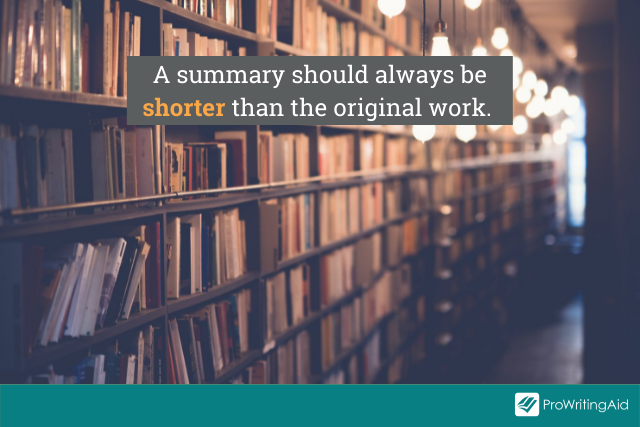
1. A summary should always be shorter than the original work, usually considerably.
Even if your summary is the length of a full paper, you are likely summarizing a book or other significantly longer work.
2. A summary should tell the reader the highlights of what they need to know without giving them unnecessary details.
3. It should also include enough details to give a clear and honest picture.
For example, if you summarize an article that says “ The Office is the greatest television show of all time,” but don’t mention that they are specifically referring to sitcoms, then you changed the meaning of the article. That’s a problem! Similarly, if you write a summary of your job history and say you volunteered at a hospital for the last three years, but you don’t add that you only went twice in that time, it becomes a little dishonest.
4. Summaries shouldn’t contain personal opinion.
While in the longer work you are creating you might use opinion, within the summary itself, you should avoid all personal opinion. A summary is different than a review. In this moment, you aren’t saying what you think of the work you are summarizing, you are just giving your audience enough information to know what the work says or did.
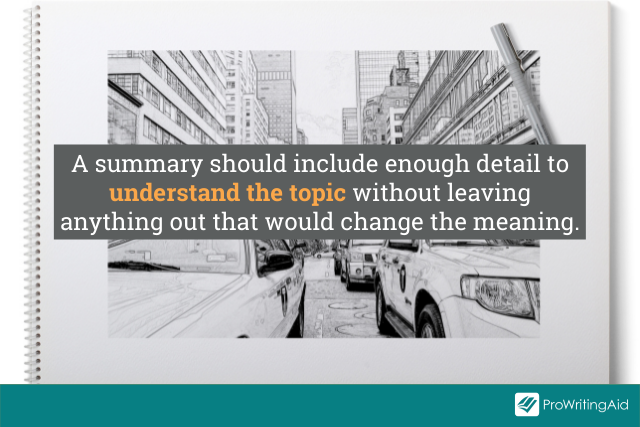
Now that we have a good idea of what summaries are in general, let’s talk about some specific types of summary you will likely have to do at some point in your writing life.
An academic summary is one you will create for a class or in other academic writing. The exact elements you will need to include depend on the assignment itself.
However, when you’re asked for an academic summary, this usually this means one of five things, all of which are pretty similar:
- You need to do a presentation in which you talk about an article, book, or report.
- You write a summary paper in which the entire paper is a summary of a specific work.
- You summarize a class discussion, lesson, or reading in the form of personal notes or a discussion board post.
- You do something like an annotated bibliography where you write short summaries of multiple works in preparation of a longer assignment.
- You write quick summaries within the body of another assignment . For example, in an argumentative essay, you will likely need to have short summaries of the sources you use to explain their argument before getting into how the source helps you prove your point.
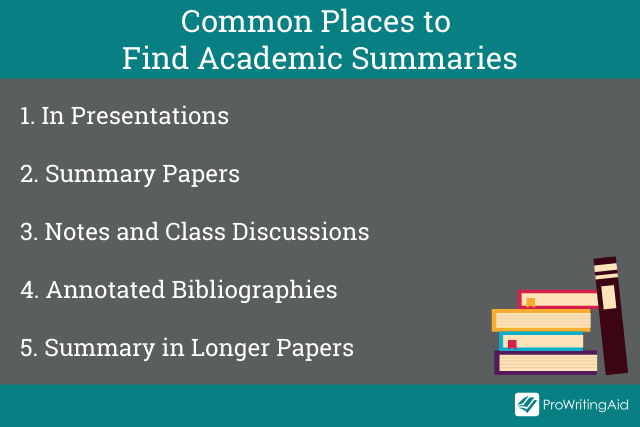
Regardless of what type of summary you are doing, though, there are a few steps you should always follow:
- Skim the work you are summarizing before you read it. Notice what stands out to you.
- Next, read it in depth . Do the same things stand out?
- Put the full text away and write in a few sentences what the main idea or point was.
- Go back and compare to make sure you didn’t forget anything.
- Expand on this to write and then edit your summary.
Each type of academic summary requires slightly different things. Let’s get down to details.
How Do I Write a Summary Paper?
Sometimes teachers assign something called a summary paper . In this, the entire thing is a summary of one article, book, story, or report.
To understand how to write this paper, let’s talk a little bit about the purpose of such an assignment.
A summary paper is usually given to help a teacher see how well a student understands a reading assignment, but also to help the student digest the reading. Sometimes, it can be difficult to understand things we read right away.
However, a good way to process the information is to put it in our own words. That is the point of a summary paper.
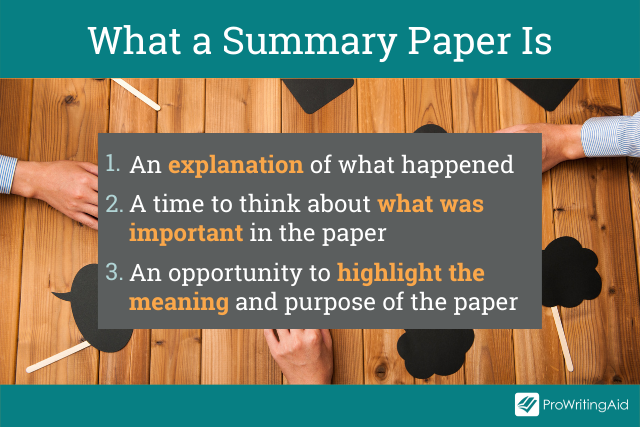
A summary paper is:
- A way to explain in our own words what happened in a paper, book, etc.
- A time to think about what was important in the paper, etc.
- A time to think about the meaning and purpose behind the paper, etc.
Here are some things that a summary paper is not:
- A review. Your thoughts and opinions on the thing you are summarizing don’t need to be here unless otherwise specified.
- A comparison. A comparison paper has a lot of summary in it, but it is different than a summary paper. In this, you are just saying what happened, but you aren’t saying places it could have been done differently.
- A paraphrase (though you might have a little paraphrasing in there). In the section on using summary in longer papers, I talk more about the difference between summaries, paraphrases, and quotes.
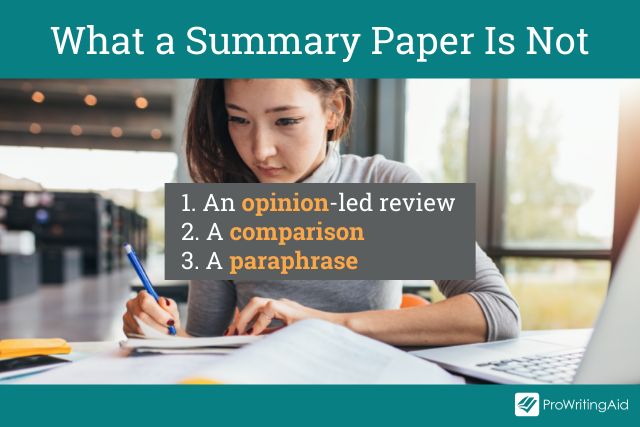
Because a summary paper is usually longer than other forms of summary, you will be able to chose more detail. However, it still needs to focus on the important events. Summary papers are usually shorter papers.
Let’s say you are writing a 3–4 page summary. You are likely summarizing a full book or an article or short story, which will be much longer than 3–4 pages.
Imagine that you are the author of the work, and your editor comes to you and says they love what you wrote, but they need it to be 3–4 pages instead.
How would you tell that story (argument, idea, etc.) in that length without losing the heart or intent behind it? That is what belongs in a summary paper.
How Do I Write Useful Academic Notes?
Sometimes, you need to write a summary for yourself in the form of notes or for your classmates in the form of a discussion post.
You might not think you need a specific approach for this. After all, only you are going to see it.
However, summarizing for yourself can sometimes be the most difficult type of summary. If you try to write down everything your teacher says, your hand will cramp and you’ll likely miss a lot.
Yet, transcribing doesn’t work because studies show that writing things down (not typing them) actually helps you remember them better.
So how do you find the balance between summarizing the lessons without leaving out important points?
There are some tips for this:
- If your professor writes it on the board, it is probably important.
- What points do your textbooks include when summarizing information? Use these as a guide.
- Write the highlight of every X amount of time, with X being the time you can go without missing anything or getting tired. This could be one point per minute, or three per five minutes, etc.
How Do I Create an Annotated Biography?
An annotated bibliography requires a very specific style of writing. Often, you will write these before a longer research paper . They will ask you to find a certain amount of articles and write a short annotation for each of them.
While an annotation is more than just a summary, it usually starts with a summary of the work. This will be about 2–3 sentences long. Because you don’t have a lot of room, you really have to think about what the most important thing the work says is.
This will basically ask you to explain the point of the article in these couple of sentences, so you should focus on the main point when expressing it.
Here is an example of a summary section within an annotation about this post:
“In this post, the author explains how to write a summary in different types of settings. She walks through academic, professional, and personal summaries. Ultimately, she claims that summaries should be short explanations that get the audience caught up on the topic without leaving out details that would change the meaning.”

Can I Write a Summary Within an Essay?
Perhaps the most common type of summary you will ever do is a short summary within a longer paper.
For example, if you have to write an argumentative essay, you will likely need to use sources to help support your argument.
However, there is a good chance that your readers won’t have read those same sources.
So, you need to give them enough detail to understand your topic without spending too much time explaining and not enough making your argument.
While this depends on exactly how you are using summary in your paper, often, a good amount of summary is the same amount you would put in an annotation.
Just a few sentences will allow the reader to get an idea of the work before moving on to specific parts of it that might help your argument.
What’s the Difference Between Summarizing, Paraphrasing, and Using Quotes?
One important thing to recognize when using summaries in academic settings is that summaries are different than paraphrases or quotes.
A summary is broader and more general. A paraphrase, on the other hand, puts specific parts into your own words. A quote uses the exact words of the original. All of them, however, need to be cited.
Let’s look at an example:
Take these words by Thomas J. Watson:
”Would you like me to give you a formula for success? It’s quite simple, really. Double your rate of failure. You are thinking of failure as the enemy of success. But it isn’t as all. You can be discouraged by failure—or you can learn from it. So go ahead and make mistakes. Make all you can. Because, remember, that’s where you will find success.”
Let’s say I was told to write a summary, a paraphrase, and a quote about this statement. This is what it might look like:
Summary: Thomas J. Watson said that the key to success is actually to fail more often. (This is broad and doesn’t go into details about what he says, but it still gives him credit.)
Paraphrase: Thomas J. Watson, on asking if people would like his formula for success, said that the secret was to fail twice as much. He claimed that when you decide to learn from your mistakes instead of being disappointed by them, and when you start making a lot of them, you will actually find more success. (This includes most of the details, but it is in my own words, while still crediting the source.)
Quote: Thomas J. Watson said, ”Would you like me to give you a formula for success? It’s quite simple, really. Double your rate of failure. You are thinking of failure as the enemy of success. But it isn’t at all. You can be discouraged by failure—or you can learn from it. So go ahead and make mistakes. Make all you can. Because, remember, that’s where you will find success.” (This is the exact words of the original with quotation marks and credit given.)
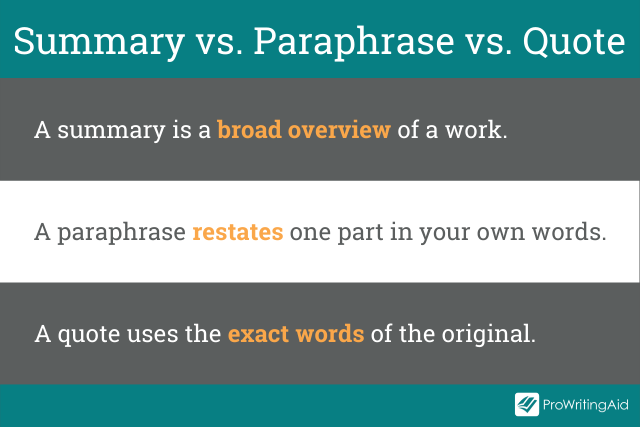
Avoiding Plagiarism
One of the hardest parts about summarizing someone else’s writing is avoiding plagiarism .

That’s why I have a few rules/tips for you when summarizing anything:
1. Always cite.
If you are talking about someone else’s work in any means, cite your source. If you are summarizing the entire work, all you probably need to do (depending on style guidelines) is say the author’s name. However, if you are summarizing a specific chapter or section, you should state that specifically. Finally, you should make sure to include it in your Work Cited or Reference page.
2. Change the wording.
Sometimes when people are summarizing or paraphrasing a work, they get too close to the original, and actually use the exact words. Unless you use quotation marks, this is plagiarism. However, a good way to avoid this is to hide the article while you are summarizing it. If you don’t have it in front of you, you are less likely to accidentally use the exact words. (However, after you are done, double check that you didn’t miss anything important or give wrong details.)
3. Use a plagiarism checker.
Of course, when you are writing any summary, especially academic summaries, it can be easy to cross the line into plagiarism. If this is a place where you struggle, then ProWritingAid can help.
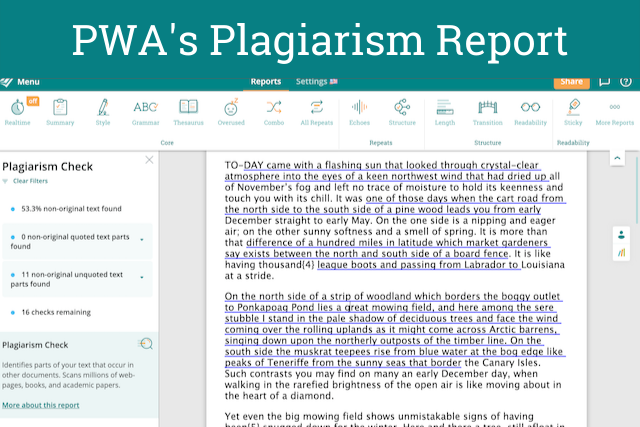
Just use our Plagiarism Report . It’ll highlight any unoriginal text in your document so you can make sure you are citing everything correctly and summarizing in your own words.
Find out more about ProWritingAid plagiarism bundles.
Along with academic summaries, you might sometimes need to write professional summaries. Often, this means writing a summary about yourself that shows why you are qualified for a position or organization.
In this section, let’s talk about two types of professional summaries: a LinkedIn summary and a summary section within a resume.
How Do I Write My LinkedIn Bio?
LinkedIn is all about professional networking. It offers you a chance to share a brief glimpse of your professional qualifications in a paragraph or two.
This can then be sent to professional connections, or even found by them without you having to reach out. This can help you get a job or build your network.
Your summary is one of the first things a future employer might see about you, and how you write yours can make you stand out from the competition.

Here are some tips on writing a LinkedIn summary :
- Before you write it, think about what you want it to do . If you are looking for a job, what kind of job? What have you done in your past that would stand out to someone hiring for that position? That is what you will want to focus on in your summary.
- Be professional . Unlike many social media platforms, LinkedIn has a reputation for being more formal. Your summary should reflect that to some extent.
- Use keywords . Your summary is searchable, so using keywords that a recruiter might be searching for can help them find you.
- Focus on the start . LinkedIn shows the first 300 characters automatically, and then offers the viewer a chance to read more. Make that start so good that everyone wants to keep reading.
- Focus on accomplishments . Think of your life like a series of albums, and this is your speciality “Greatest Hits” album. What “songs” are you putting on it?

How Do I Summarize My Experience on a Resume?
Writing a professional summary for a resume is different than any other type of summary that you may have to do.
Recruiters go through a lot of resumes every day. They don’t have time to spend ages reading yours, which means you have to wow them quickly.
To do that, you might include a section at the top of your resume that acts almost as an elevator pitch: That one thing you might say to a recruiter to get them to want to talk to you if you only had a 30-second elevator ride.
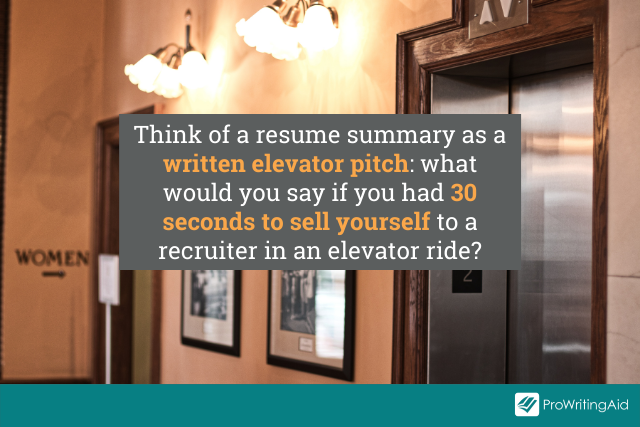
If you don’t have a lot of experience, though, you might want to skip this section entirely and focus on playing up the experience you do have.
Outside of academic and personal summaries, you use summary a lot in your day-to-day life.
Whether it is telling a good piece of trivia you just learned or a funny story that happened to you, or even setting the stage in creative writing, you summarize all the time.
How you use summary can be an important consideration in whether people want to read your work (or listen to you talk).
Here are some things to think about when telling a story:
- Pick interesting details . Too many and your point will be lost. Not enough, and you didn’t paint the scene or give them a complete idea about what happened.
- Play into the emotions . When telling a story, you want more information than the bare minimum. You want your reader to get the emotion of the story. That requires a little bit more work to accomplish.
- Focus. A summary of one story can lead to another can lead to another. Think about storytellers that you know that go off on a tangent. They never seem to finish one story without telling 100 others!

To wrap up (and to demonstrate everything I just talked about), let’s summarize this post into its most essential parts:
A summary is a great way to quickly give your audience the information they need to understand the topic you are discussing without having to know every detail.
How you write a summary is different depending on what type of summary you are doing:
- An academic summary usually gets to the heart of an article, book, or journal, and it should highlight the main points in your own words. How long it should be depends on the type of assignment it is.
- A professional summary highlights you and your professional, academic, and volunteer history. It shows people in your professional network who you are and why they should hire you, work with you, use your talents, etc.
Being able to tell a good story is another form of summary. You want to tell engaging anecdotes and facts without boring your listeners. This is a skill that is developed over time.
Take your writing to the next level:

20 Editing Tips from Professional Writers
Whether you are writing a novel, essay, article, or email, good writing is an essential part of communicating your ideas., this guide contains the 20 most important writing tips and techniques from a wide range of professional writers..

Be confident about grammar
Check every email, essay, or story for grammar mistakes. Fix them before you press send.

Ashley Shaw
Ashley Shaw is a former editor and marketer/current PhD student and teacher. When she isn't studying con artists for her dissertation, she's thinking of new ways to help college students better understand and love the writing process. You can follow her on Twitter, or, if you prefer animal accounts, follow her rabbits, Audrey Hopbun and Fredra StaHare, on Instagram.
Get started with ProWritingAid

All features—half price
Save 50% on yearly and lifetime plans
this Black Friday.
Grab the discount while it lasts.
Visit our Help Center or let's stay in touch via:

Summary: Using it Wisely
What this handout is about.
Knowing how to summarize something you have read, seen, or heard is a valuable skill, one you have probably used in many writing assignments. It is important, though, to recognize when you must go beyond describing, explaining, and restating texts and offer a more complex analysis. This handout will help you distinguish between summary and analysis and avoid inappropriate summary in your academic writing.
Is summary a bad thing?
Not necessarily. But it’s important that your keep your assignment and your audience in mind as you write. If your assignment requires an argument with a thesis statement and supporting evidence—as many academic writing assignments do—then you should limit the amount of summary in your paper. You might use summary to provide background, set the stage, or illustrate supporting evidence, but keep it very brief: a few sentences should do the trick. Most of your paper should focus on your argument. (Our handout on argument will help you construct a good one.)
Writing a summary of what you know about your topic before you start drafting your actual paper can sometimes be helpful. If you are unfamiliar with the material you’re analyzing, you may need to summarize what you’ve read in order to understand your reading and get your thoughts in order. Once you figure out what you know about a subject, it’s easier to decide what you want to argue.
You may also want to try some other pre-writing activities that can help you develop your own analysis. Outlining, freewriting, and mapping make it easier to get your thoughts on the page. (Check out our handout on brainstorming for some suggested techniques.)
Why is it so tempting to stick with summary and skip analysis?
Many writers rely too heavily on summary because it is what they can most easily write. If you’re stalled by a difficult writing prompt, summarizing the plot of The Great Gatsby may be more appealing than staring at the computer for three hours and wondering what to say about F. Scott Fitzgerald’s use of color symbolism. After all, the plot is usually the easiest part of a work to understand. Something similar can happen even when what you are writing about has no plot: if you don’t really understand an author’s argument, it might seem easiest to just repeat what he or she said.
To write a more analytical paper, you may need to review the text or film you are writing about, with a focus on the elements that are relevant to your thesis. If possible, carefully consider your writing assignment before reading, viewing, or listening to the material about which you’ll be writing so that your encounter with the material will be more purposeful. (We offer a handout on reading towards writing .)
How do I know if I’m summarizing?
As you read through your essay, ask yourself the following questions:
- Am I stating something that would be obvious to a reader or viewer?
- Does my essay move through the plot, history, or author’s argument in chronological order, or in the exact same order the author used?
- Am I simply describing what happens, where it happens, or whom it happens to?
A “yes” to any of these questions may be a sign that you are summarizing. If you answer yes to the questions below, though, it is a sign that your paper may have more analysis (which is usually a good thing):
- Am I making an original argument about the text?
- Have I arranged my evidence around my own points, rather than just following the author’s or plot’s order?
- Am I explaining why or how an aspect of the text is significant?
Certain phrases are warning signs of summary. Keep an eye out for these:
- “[This essay] is about…”
- “[This book] is the story of…”
- “[This author] writes about…”
- “[This movie] is set in…”
Here’s an example of an introductory paragraph containing unnecessary summary. Sentences that summarize are in italics:
The Great Gatsby is the story of a mysterious millionaire, Jay Gatsby, who lives alone on an island in New York. F. Scott Fitzgerald wrote the book, but the narrator is Nick Carraway. Nick is Gatsby’s neighbor, and he chronicles the story of Gatsby and his circle of friends, beginning with his introduction to the strange man and ending with Gatsby’s tragic death. In the story, Nick describes his environment through various colors, including green, white, and grey. Whereas white and grey symbolize false purity and decay respectively, the color green offers a symbol of hope.
Here’s how you might change the paragraph to make it a more effective introduction:
In The Great Gatsby, F. Scott Fitzgerald provides readers with detailed descriptions of the area surrounding East Egg, New York. In fact, Nick Carraway’s narration describes the setting with as much detail as the characters in the book. Nick’s description of the colors in his environment presents the book’s themes, symbolizing significant aspects of the post-World War I era. Whereas white and grey symbolize the false purity and decay of the 1920s, the color green offers a symbol of hope.
This version of the paragraph mentions the book’s title, author, setting, and narrator so that the reader is reminded of the text. And that sounds a lot like summary—but the paragraph quickly moves on to the writer’s own main topic: the setting and its relationship to the main themes of the book. The paragraph then closes with the writer’s specific thesis about the symbolism of white, grey, and green.
How do I write more analytically?
Analysis requires breaking something—like a story, poem, play, theory, or argument—into parts so you can understand how those parts work together to make the whole. Ideally, you should begin to analyze a work as you read or view it instead of waiting until after you’re done—it may help you to jot down some notes as you read. Your notes can be about major themes or ideas you notice, as well as anything that intrigues, puzzles, excites, or irritates you. Remember, analytic writing goes beyond the obvious to discuss questions of how and why—so ask yourself those questions as you read.
The St. Martin’s Handbook (the bulleted material below is quoted from p. 38 of the fifth edition) encourages readers to take the following steps in order to analyze a text:
- Identify evidence that supports or illustrates the main point or theme as well as anything that seems to contradict it.
- Consider the relationship between the words and the visuals in the work. Are they well integrated, or are they sometimes at odds with one another? What functions do the visuals serve? To capture attention? To provide more detailed information or illustration? To appeal to readers’ emotions?
- Decide whether the sources used are trustworthy.
- Identify the work’s underlying assumptions about the subject, as well as any biases it reveals.
Once you have written a draft, some questions you might want to ask yourself about your writing are “What’s my point?” or “What am I arguing in this paper?” If you can’t answer these questions, then you haven’t gone beyond summarizing. You may also want to think about how much of your writing comes from your own ideas or arguments. If you’re only reporting someone else’s ideas, you probably aren’t offering an analysis.
What strategies can help me avoid excessive summary?
- Read the assignment (the prompt) as soon as you get it. Make sure to reread it before you start writing. Go back to your assignment often while you write. (Check out our handout on reading assignments ).
- Formulate an argument (including a good thesis) and be sure that your final draft is structured around it, including aspects of the plot, story, history, background, etc. only as evidence for your argument. (You can refer to our handout on constructing thesis statements ).
- Read critically—imagine having a dialogue with the work you are discussing. What parts do you agree with? What parts do you disagree with? What questions do you have about the work? Does it remind you of other works you’ve seen?
- Make sure you have clear topic sentences that make arguments in support of your thesis statement. (Read our handout on paragraph development if you want to work on writing strong paragraphs).
- Use two different highlighters to mark your paper. With one color, highlight areas of summary or description. With the other, highlight areas of analysis. For many college papers, it’s a good idea to have lots of analysis and minimal summary/description.
- Ask yourself: What part of the essay would be obvious to a reader/viewer of the work being discussed? What parts (words, sentences, paragraphs) of the essay could be deleted without loss? In most cases, your paper should focus on points that are essential and that will be interesting to people who have already read or seen the work you are writing about.
But I’m writing a review! Don’t I have to summarize?
That depends. If you’re writing a critique of a piece of literature, a film, or a dramatic performance, you don’t necessarily need to give away much of the plot. The point is to let readers decide whether they want to enjoy it for themselves. If you do summarize, keep your summary brief and to the point.
Instead of telling your readers that the play, book, or film was “boring,” “interesting,” or “really good,” tell them specifically what parts of the work you’re talking about. It’s also important that you go beyond adjectives and explain how the work achieved its effect (how was it interesting?) and why you think the author/director wanted the audience to react a certain way. (We have a special handout on writing reviews that offers more tips.)
If you’re writing a review of an academic book or article, it may be important for you to summarize the main ideas and give an overview of the organization so your readers can decide whether it is relevant to their specific research interests.
If you are unsure how much (if any) summary a particular assignment requires, ask your instructor for guidance.
Works consulted
We consulted these works while writing this handout. This is not a comprehensive list of resources on the handout’s topic, and we encourage you to do your own research to find additional publications. Please do not use this list as a model for the format of your own reference list, as it may not match the citation style you are using. For guidance on formatting citations, please see the UNC Libraries citation tutorial . We revise these tips periodically and welcome feedback.
Barnet, Sylvan. 2015. A Short Guide to Writing about Art , 11th ed. Upper Saddle River, NJ: Prentice Hall.
Corrigan, Timothy. 2014. A Short Guide to Writing About Film , 9th ed. New York: Pearson.
Lunsford, Andrea A. 2015. The St. Martin’s Handbook , 8th ed. Boston: Bedford/St Martin’s.
Zinsser, William. 2001. On Writing Well: The Classic Guide to Writing Nonfiction , 6th ed. New York: Quill.
You may reproduce it for non-commercial use if you use the entire handout and attribute the source: The Writing Center, University of North Carolina at Chapel Hill
Make a Gift
How to Summarize an Article: Techniques & Tips

When you don’t have time to read a full article, an article summary can give you the information you’re looking for. You’ve probably read lots of article summaries, but have you ever tried your hand at writing one? If not, don’t fret. Read on to learn how to summarize an article like a pro.
What is an article summary?
An article summary is an overview of an article that highlights its key points. An effective summary does not include all of the article’s specific details; it simply acts as a preview that can help readers decide whether to read the full version.
Learning how to summarize an article is crucial because it helps you handle texts more effectively. For instance, imagine you’re writing an essay and need to refer to three academic articles. By including short summaries of these articles, you can clearly explain why they’re important without getting lost in unnecessary details. In other words, summarizing saves time and helps you convey the main ideas concisely.
Work smarter with Grammarly The AI writing partner for anyone with work to do Get Grammarly
Steps to summarize an article effectively
Read the article.
You need to understand an article in order to summarize it effectively. Read the original text and take notes about its key points, thesis statement, most important details, and overall position.
Identify the main points and/or supporting arguments
With the notes you took as you read the article, write an outline that notes its main points and supporting arguments. This outline doesn’t need to be as detailed as an outline for an essay—it’s just a sketch you can use to make sure you cover all the necessary points when you write your summary.
Then determine the article’s main idea by identifying the central theme or argument the author presents and supports throughout the article. This typically appears near the beginning of the article, often in the introduction or early paragraphs. From here, determine any other “big picture” points the article makes and identify the details that support these points. Anything that isn’t a main idea or supporting argument can be left aside, as these aren’t important enough to be included in your summary.
Write the summary in your own words
Next, write a summary. Don’t worry about making it perfect; this is just the first draft. Aim to write no more than 250 words, or about a paragraph or two.
When you write a summary, you’re not copying the original article’s text verbatim. Rather, you’re writing a shortened version that skips to the main idea. You can do this by starting your summary with a shortened version of the article’s thesis statement, put into your own words. You can also start with a brief statement of the original’s position, then follow it with the most important supporting argument. To avoid plagiarism issues, be sure to cite the article’s title and author in your summary.
Keep it objective
A summary isn’t your opinion about the original article. To write an effective summary, keep your tone neutral and objective. Save your interpretations and analysis of the text for an analytical essay.
Revise and edit your summary
After you’ve written an article summary, take a moment to read it with a critical eye. As you read, note any grammatical mistakes you’ve made or places in your writing where you can improve its clarity and/or flow. Then, make the necessary edits to polish it into a sparkling second draft.
Grammarly can help you with this part. With Grammarly’s AI summarizing tool , summarizing an article is fast and easy. It’s also a great complement to Grammarly’s plagiarism and grammar checkers. Remember, though, that tools like these exist to help with your writing, not do the work for you—to get the best results, summarize an article yourself, then use AI to catch mistakes and show you places where you can strengthen your writing.
Tips for effective summarization
When you’re taking notes for a summary, bulleted lists can be extremely helpful. Jot down a bulleted list of the article’s main points and the supporting arguments for each of these points.
If you find yourself having a difficult time identifying the article’s main points and supporting arguments, write down the following questions:
- What goal is this article trying to achieve? For example, is it trying to inform, persuade, or entertain the reader?
- How does the article achieve this goal?
- What is the article’s topic?
- What is the author’s position regarding the article’s topic?
Then read the article again, carefully looking for answers to these questions. Be sure to answer these questions using the text, rather than attempting to fill in the blanks with your own interpretations.
Another important tip is to write your summary with your reader in mind. If your summary is intended for an academic audience , you have more leeway to use complex and subject-specific vocabulary than if you were writing for a general audience.
Common mistakes to avoid in article summarization
As you learn how to summarize a news article , familiarizing yourself with common mistakes can help you avoid them. Important mistakes to avoid include:
- Restating the original article’s text word-for-word. This is plagiarism, which can lead to professional and/or academic consequences.
- Forgetting to cite the original article’s title and author. This, too, is plagiarism. Make sure to always cite your source.
- Including irrelevant details. In a summary of an article on changing bird migration patterns, the color of the birds’ feathers isn’t relevant. Stick to the article’s main idea and supporting evidence in your summary.
- Oversimplifying complex topics. A summary is a concise overview of an article, not a watered-down version. Your summary’s job isn’t to make the article more accessible to readers; its purpose is to help them decide whether or not to read the original.
- Omitting key points from the original. A strong summary captures its source’s thesis statement and all relevant points and communicates them clearly.
Examples of summarized articles
On Monday, the Associated Press reported that the Eiffel Tower was closed due to a strike over poor financial management. The landmark has seen a surge in visitors ahead of the Summer Olympics in Paris. Visitors were advised of disruptions on the website, and electronic ticket owners were told to check their inboxes beforehand. The CGT union, representing many of the tower’s employees, said the strike aimed to increase salaries proportionally to ticket sales and to improve maintenance. The operator’s business model was criticized for prioritizing short-term benefits over long-term conservation. This is the second closure in two months due to strikes.
Original article: https://www.yahoo.com/lifestyle/strike-eiffel-tower-paris-disrupts-103443735.html
The Associated Press reported that a strong storm hit Northern California on Sunday, with strong winds and heavy rainfall expected to move south over the next few days. There is a risk of flooding, hail, and brief tornadoes in some areas, with up to five inches of rain predicted for many areas and isolated rain totals of up to ten inches in some mountain ranges. The storm is expected to move through more quickly than the previous one that caused severe damage earlier this month. Flood watches and warnings have been issued along the coast and in mountainous regions, and motorists are advised to avoid mountain routes. The Governor’s Office of Emergency Services has activated its operations center and positioned personnel and equipment in high-risk areas.
Original article: https://www.yahoo.com/news/flood-watches-issued-another-round-214139804.html
Article summarization FAQs
What is article summarization.
Article summarization is the method of writing a shortened, simplified overview of an article. Generally, an article summary is about 250 words.
How do I ensure my article summarization is unbiased and objective?
To ensure your article summary is unbiased and objective, simply state the original article’s main idea and supporting points, rather than comment on or interpret them. Use neutral, academic language and avoid mentioning your agreement (or disagreement) with its author.
How can I avoid plagiarism when summarizing?
Here are three important ways to avoid plagiarism when summarizing an article:
- Cite the article in your summary and, if you use AI to generate your summary, acknowledge your use of AI. Grammarly’s citation generator makes this easy.
- Don’t repeat the original article’s text verbatim. Instead, summarize it in your own words. Use Grammarly’s plagiarism checker to detect plagiarism in your text.
- Navigate responsible AI use with Grammarly’s AI checker , trained to identify AI-generated text.
How can I make my article summary stand out?
Make your article summary stand out by getting straight to the original article’s point, hooking the reader with an intriguing concept or perspective without giving away all its details.
How can I use AI to summarize articles?
Grammarly’s AI summarization tool can make it easy to summarize an article, letting you highlight its key points in a concise paragraph with just a few clicks.


IMAGES
VIDEO
COMMENTS
Table of contents. When to write a summary. Step 1: Read the text. Step 2: Break the text down into sections. Step 3: Identify the key points in each section. Step 4: Write the summary. Step 5: Check the summary against the article. Other interesting articles. Frequently asked questions about summarizing.
1 Read or watch the source material. The first step is fairly obvious: Read or watch whatever it is you’re writing a summary about. If you’re doing a book report or similar paper, there’s always a temptation to skip this step and just rely on other people’s summaries. We don’t recommend it, though.
To effectively summarize an essay, follow these steps: 1 Read the essay: Fully read the essay to understand its main argument and structure. As you do this, identify the essay’s thesis statement and main arguments, which will be featured in your summary. 2 Identify main points: Pinpoint the key points and arguments within the essay.
1. Present the summary in a block of paragraphs, followed by the response in a block: Intro/thesis. Summary (two to three paragraphs) Agreement (or disagreement) Disagreement (or agreement) Conclusion. Note: Some essays will incorporate both agreement and disagreement in a response, but this is not mandatory. 2.
Also, a summarization isn’t necessarily always confined to writing; you can verbally summarize something, too. However, the steps below are designed to help you compose a written summary. 1. Read and take notes. First things first: Read or watch the original work you’ll be summarizing.
2. Write down what you think the main point of the piece is. This will help you start to put the piece's arguments in your own words. You can also ask yourself what point or points or themes come up throughout the entire piece. The title can also give you a tip as to the main point of the piece. [1]
Even if your summary is the length of a full paper, you are likely summarizing a book or other significantly longer work. 2. A summary should tell the reader the highlights of what they need to know without giving them unnecessary details. 3. It should also include enough details to give a clear and honest picture.
Summary Writing Steps. A summary is telling the main ideas of the article in your own words. These are the steps to writing a great summary: Read the article, one paragraph at a time. For each paragraph, underline the main idea sentence (topic sentence). If you can't underline the book, write that sentence on your computer or a piece of paper.
You might use summary to provide background, set the stage, or illustrate supporting evidence, but keep it very brief: a few sentences should do the trick. Most of your paper should focus on your argument. (Our handout on argument will help you construct a good one.) Writing a summary of what you know about your topic before you start drafting ...
A summary isn’t your opinion about the original article. To write an effective summary, keep your tone neutral and objective. Save your interpretations and analysis of the text for an analytical essay. Revise and edit your summary. After you’ve written an article summary, take a moment to read it with a critical eye.